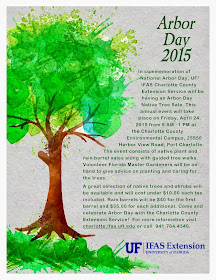Is the yucca plant new to you? This
arid plant may look interesting enough to add to your landscape plant
palette choices. Yuccas are plants that have stiff, dagger-like leaves and
stunning spikes of white flowers. Drought-tolerant and hardy, yuccas are
Florida-Friendly Landscaping™ plants worthy of your attention.
First, a word of caution - with common names such as Spanish
Bayonet, some yuccas are known for their dangerously sharp needle-like
tips. Fortunately, these sharp tips can be rendered harmless by clipping
them off with pruners. There is also a spineless yucca which has
needle-less leaves.
A Florida native yucca, the Spanish Bayonet or Yucca
aloifolia, is a tall plant up to fifteen feet in height which may even form
multi-stemmed clumps. The dark green leaves of this yucca must be
de-needled with pruners for safety purposes. If you want these plants
fully armed with their needles, this yucca should be placed away from areas
where people may travel. Otherwise, they can used as spiny security plants
strategically placed near sites where you do not want intruders. Yucca
aloifolia is known to occasionally fall over and start new plants,
so give them plenty of space for expansion. A very drought-tolerant
plant, the leaf margins of this yucca are rough to the touch. Although
the Spanish Bayonet prefers full sun to part shade, they will even thrive in
almost full shade conditions. One colorful cultivar to look for is called
‘Tricolor’ which has green and white leaves.
For those gardeners that want a naturally “de-clawed” yucca,
try the Spineless Yucca, a.k.a. Soft-Tip Yucca or Yucca elephantipes. Brought
to Florida in 1956, and much taller than the other yuccas, the
Spineless Yucca grows up to thirty-feet tall and fifteen feet wide. This
non-native yucca is a very fast grower in comparison with the other yuccas and
has a large single trunk with impressive four-foot-long leaves. A
multi-trunked tree may develop over time from sprouts at the base. Once
they reach eight to ten feet tall, Spineless Yuccas are able to produce a
spectacular three-foot-tall bloom. This yucca can also be kept as a
houseplant. In the landscape, the Spineless Yucca must have excellent
drainage.
Yuccas, both spiny and spineless, can make an interesting
accent to your landscape, so make it a point to add one to your yard! For
more information on all types of different ornamental plant materials suitable
for our area, please call our Master Gardener volunteers on the Plant
Lifeline on Mondays, Wednesdays and Fridays from 1 to 4 pm at 764-4340 for
gardening help and insight into their role as an Extension volunteer.
Don't forget to visit our other County Plant Clinics in the area. Please
check this link for a complete list of site locations, dates and times - http://charlotte.ifas.ufl.edu/horticulture/Plant%20Clinics%20Schedule.pdf.
Resources:
Gilman, E. F. & Watson, D. G. (2011) Yucca
elephantipes : Spineless Yucca. The University of Florida Extension
Service, IFAS.
Gilman, E. F. & Watson, D. G. (2011) Yucca
elephantipes 'Variegata': Variegated Spineless Yucca. The University of
Florida Extension Service, IFAS.
Gilman, E. F. (2011) Yucca aloifolia. The
University of Florida Extension Service, IFAS.
Knox, G. W. (2013) Agave and Yucca: Tough Plants for Tough
Times. The University of Florida Extension Service, IFAS.
Brown, S. H. (2012) Yucca aloifolia. The University
of Florida Extension Service, IFAS – Lee County.
Christman, S. (2004) Yucca aloifolia. Floridata.com,
Tallahasshee, FL.





